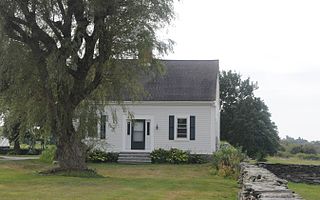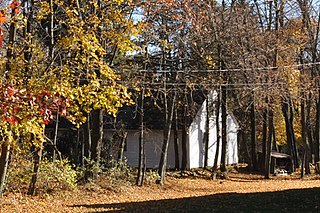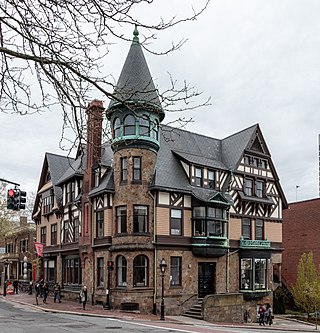
Wakefield is a village in the town of South Kingstown, Rhode Island, United States, and the commercial center of South Kingstown. Together with the village of Peace Dale, it is treated by the U.S. Census as a component of the census-designated place identified as Wakefield-Peacedale, Rhode Island. West Kingston, another South Kingstown village, was the traditional county seat of Washington County. Since 1991, the Washington County Courthouse has been in Wakefield. The Sheriff's Office which handles corrections is also in Wakefield.

Saunderstown is a small village and historic district in the towns of Narragansett and North Kingstown in Washington County, Rhode Island, United States. It was named in honor of John Aldrich Saunders, a member of the Saunders family. Saunderstown has its own post office with the ZIP Code of 02874, which also includes a small part of South Kingstown. Its population is 6,245.

Casey Farm is a historic farm in Saunderstown, Rhode Island, United States. It is now a historic museum property, operated by Historic New England, and is open to the public.

Union Village or "Bank Village" is a village and historic district located in North Smithfield and Woonsocket, Rhode Island on Rhode Island Route 146A. Union Village developed because it was at the cross roads of old Great Road and Pound Hill Road.

The Smithfield Exchange Bank, built in 1822, is located on Putnam Pike in the Greenville area of Smithfield, Rhode Island.

The Bailey Farm is an historic farm at 373 Wyatt Road in Middletown, Rhode Island. Now reduced from more than 100 acres (40 ha) to about 45 acres (18 ha), the farm is a well-preserved example of a 19th-century island farm. It was owned by members of the Bailey family, possibly as early as the late 17th century, into the 19th century. The original main house appears to be a mid-18th century structure that was given a significant Greek Revival treatment in the 19th century. It is a 1-1/2 story Cape style house, three bays wide, with a central chimney. The main entrance is centered on the northern facade, and is flanked by sidelight windows and pilasters, with an entablature above. The corners of the building are pilastered. A series of outbuildings stand nearby. There is a second complex of buildings on the northwest part of the property, built in the 1930s near the location of the Bailey family cemetery.

The Jamestown Windmill is a smock mill in Jamestown, Rhode Island within the Windmill Hill Historic District on North Road north of Weeden Lane.

Greenvale Farm is an historic farm and 19th-century summer estate at 582 Wapping Road in Portsmouth, Rhode Island. Historically used for farmland, a portion of this 53-acre (21 ha) was transformed into an expansive country estate in the 1860s by John Barstow, a Boston merchant. It is located at the end of a narrow dirt lane, and is set overlooking the Sakonnet River. The main house, designed by John Hubbard Sturgis and built in 1864–65, is an exuberant implementation of the Stick style with Gothic features. It has asymmetric form, with a variety of projections, dormers, gables, and cross-gables, with a variety of exterior finishes. The estate continues to be owned by Barstow descendants.

The Lawton–Almy–Hall Farm is an historic farm at 559 Union Street in Portsmouth, Rhode Island. The farm comprises 40 acres (16 ha) of land, and a well-preserved farm complex with elements dating to the 18th century. The land was first granted in 1648 to George Lawton, and was owned by six generations of the family. It was acquired in 1832 by Peleg Almy, whose family owned it until 1938, when it was sold to the Halls. The farmhouse is one of the oldest in the area, with its northern section estimated to have been built about 1700, based on stylistic resemblance to the Quaker Meetinghouse and a local schoolhouse.

The John Cole Farm is an historic colonial farm on Reservoir Road in the far northeast of Cumberland, Rhode Island. The main farmhouse, a 1+1⁄2-story Cape style wood-frame structure, was built c. 1770 by John Cole not long after his acquisition of the property. The property, including a half-dozen outbuildings, has had only minimal intrusion of modern 20th-century amenities, and is a well-kept example of vernacular rural architecture of the late 18th century.

Mt. Hygeia is an historic farm property at 83 Mt. Hygeia Road in Foster, Rhode Island, United States.

The Allen–Madison House is a historic house on Marine Road in North Kingstown, Rhode Island. It is located on the grounds of the former Davisville Naval Construction Battalion Center, set on an isolated plot apart from the main portion of the base.

The Dr. George W. Carr House, also known simply as Carr House, is a historic house at 29 Waterman Street in the College Hill neighborhood of Providence, Rhode Island. The Queen Anne style house was built in 1885 by Edward I. Nickerson and added to the National Register of Historic Places in 1973.

Grace Church is an historic Episcopal church at 300 Westminster Street at Mathewson Street in downtown Providence, Rhode Island. It was built in 1845–1846 and was designed by Richard Upjohn in the Gothic Revival style.

The Joseph Pierce Farm is an historic farm at 933 Gilbert Stuart Road in North Kingstown, Rhode Island. It consists of 18 acres (7.3 ha) of land, along with an 18th-century farmhouse and a number of 19th-century outbuildings. The oldest portion of the house, its southern ell, was originally built with a gable roof, but this was extended to the north in the late 18th or early 19th century, and given it present gambrel roof and Federal styling. Later additions in the 19th and 20th centuries gave the house its present cruciform appearance. Outbuildings dating to the 19th century include a barn with attached privy, a toolshed, and a henhouse. The complex is a well-preserved reminder of the area's rural heritage.

The Spink Farm is a historic farm at 1325 Shermantown Road in North Kingstown, Rhode Island. The only surviving element of the farmstead on this 55-acre (22 ha) farm is the main house, a 2+1⁄2-story five-bay wood-frame structure built in 1798 by Isaac Spink. The house exhibits modest Federal styling, its doorway flanked by small sidelight windows and simple pilasters, and topped by a shallow hood. The interior follows a typical center-chimney plan, with its original Federal period fireplace mantels intact. The house has been extended to the rear by a kitchen ell and porch, both added in the 20th century. The house is one of a small number of 18th-century farmsteads left in the town.

The Towers Historic District is a historic district in Narragansett, Rhode Island, encompassing a city block bounded by the Atlantic Ocean, Exchange Place, Mathewson and Taylor Streets. It is centered on The Towers, the surviving remnant of the Narragansett Casino, built 1883-86 to a design by McKim, Mead & White. This area was always near the center of resort-oriented development in Narragansett from the mid-19th century on, including four summer cottages on Taylor and Mathewson Streets built in the 1860s and 1870s. Most of the casino was destroyed by fire in 1900, leaving its stone towers, and the nearby Coast Guard station, also designed by McKim, Mead & White. The oldest building in the district is an 1822 2+1⁄2-story house at 18 Mathewson Street.

Forge Farm is an historic farm in Warwick, Rhode Island. Established in the mid-17th century by the Greene family, it is one of the oldest farms in Rhode Island. It was the birthplace of General Nathanael Greene, a prominent American general in the American Revolutionary War. The core of the main house was built in 1684 by James Greene, son of John Greene, who purchased the land from local Native Americans. It has been extended and altered numerous times in the 18th and 19th centuries. Nathanael Greene was born in this house in 1742, and the farm was owned for many years by Nathanael's brother Christopher, and wife, Deborah (Ward) Greene, daughter of Continental Congress member Samuel Ward.

The Jennys Lane Historic District is a residential historic district encompassing a well-preserved subdivision in Barrington, Rhode Island, which was developed between 1860 and 1920. It is representative of the town's development as a suburb of Providence following the introduction of passenger rail service in 1855. The district includes all of the properties on Jennys Lane, as well as some adjacent houses on Mathewson and Rumstick Roads, as well as a boathouse on Rumstick Road on the banks of the Barrington River.
Mathewson–Bice Farmhouse and Mathewson Family Cemetery is a historic home and family cemetery located at Hartwick near Cooperstown in Otsego County, New York. The property was bought in 1796 by David Mathewson and the house was built shortly after the purchase. Mathewson had moved to the area from Rhode Island with a migration after the Revolutionsry War.





















